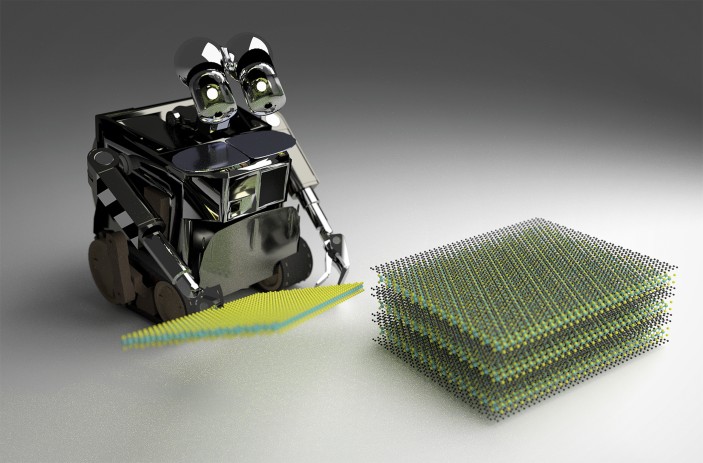(원문)
An automated robotic system is capable of assembling 2D van der Waals heterostructures of unprecedented complexity in a timely fashion.
The emergence of robotic automation in the workplace has unleashed a hot debate among economists about the potential impact of the robot replacing the traditional human labour force1,2. This possibility is closer than it may seem as we are getting increasingly familiar with concepts such as autonomous driving and artificial intelligence-powered smartphone assistants. Now it is the turn of fundamental nanotechnology researchers to wonder whether this so-called robotic revolution can be exploited to further promote fundamental discoveries in nanoscience. Writing in Nature Communications, Masubuchi, Machida and co-workers demonstrate a ‘self-operating transfer set-up’, a robotic system capable of assembling van der Waals heterostructures3.

Since the first experimental demonstration of a van der Waals heterostructure, an artificial stack of two-dimensional (2D) materials piled on top of each other, the scientific community has continuously been stimulated by the possibility of creating artificial materials with tailored properties4. Up to now, van der Waals heterostructures have been handcrafted by patient and skilled researchers using deterministic placement techniques5,6. The most complicated stack fabricated to date is a manually assembled multiple-quantum-well heterostructure reported by Withers and co-authors7. The assembly was composed of 13 alternating layers of graphene, MoS2 and boron nitride and would have taken days to complete. The new robotic set-up implemented by Masubuchi et al. has already beaten this already impressive record by stacking 29 layers of graphene and boron nitride in just 32 hours.
The robotic system developed by Masubuchi et al. automatically searches exfoliated 2D crystals and assembles them into van der Waals heterostructures of arbitrary user-defined complexity. The system, which is composed of an automated optical microscope, a chip transfer robotic arm and a stamping apparatus, is contained in a glove box that allows for environmental control, which is often required to work with air-sensitive 2D materials and to reduce the presence of interlayer organic adsorbates. Using an efficient computer-vision algorithm, the system is capable of analysing 12,000 optical microscope images per hour (more than 3 images per second) to identify mechanically exfoliated flakes and sort them depending on their thickness. In the case of exfoliated graphite, the machine identified 400 monolayer graphene flakes per hour, whereas with MoS2 the system identified 60 monolayers per hour with a false identification rate lower than 8%. The location and morphological characteristics of the identified 2D crystals are stored in a database that can be easily accessed by users. The final assembly of the crystals in the desired van der Waals stack is then realized by robots, directed by the computer-vision algorithm, that pick up different 2D crystals in the desired order and orientation and assemble the heterostructure onto a polymer stamp.
The implications of this work go beyond the invention of a tool to make life easier for the researchers working on 2D materials. In fact, this innovation creates the opportunity for the fabrication of complex stacks that cannot be produced with the currently available manual transfer methods. Considering the complexity of the fabricated samples, this tool will undoubtedly come in handy when studying new physical phenomena. For example, fabricating stacks with ~30 layers could enable studies dealing with user-defined atomic superlattices based on 2D materials. Additionally, such a robotic set-up will also be beneficial for the large-scale integration, which requires precise and reproducible methods for isolating and stacking of 2D sheets.
This experimental development, however, presents a number of challenges. Some of the biggest questions that remain include how to achieve a full automation of the transfer process (this system still needs an operator to supervise, and correct if needed, the alignment process due to the current lateral error of 10 μm in the automated alignment) and how to ensure an environmentally controlled atmosphere during the whole process (in the current implementation some of the processes — the exfoliation of the flakes and the transfer of the assembled stack onto the final acceptor substrate — are carried out in air, which represents a serious drawback when working with air-sensitive materials). Another long-term challenge is the operating complexity of the transfer system for potential users. This issue remains to be resolved despite the effort on the authors’ part to provide a comprehensive description of the set-up and even to share the software in an open repository. Indeed, the recent experience demonstrated that the success of many experimental techniques, such as the mechanical exfoliation of 2D materials, strongly relies on their ability to be easily adopted by other groups. Yet despite the remaining issues, the demonstrated robotic set-up represents an important step towards the realization of 2D-based devices with arbitrary complexity.